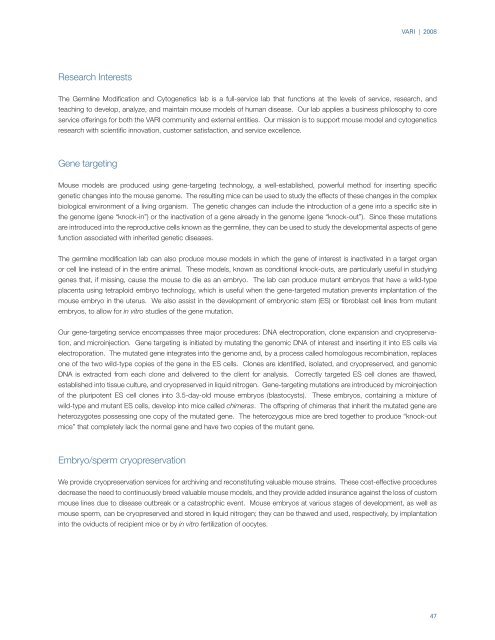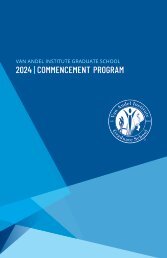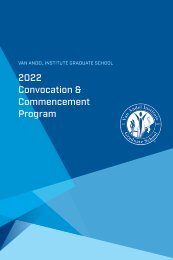2008 Scientific Report
You also want an ePaper? Increase the reach of your titles
YUMPU automatically turns print PDFs into web optimized ePapers that Google loves.
VARI | <strong>2008</strong><br />
Research Interests<br />
The Germline Modification and Cytogenetics lab is a full-service lab that functions at the levels of service, research, and<br />
teaching to develop, analyze, and maintain mouse models of human disease. Our lab applies a business philosophy to core<br />
service offerings for both the VARI community and external entities. Our mission is to support mouse model and cytogenetics<br />
research with scientific innovation, customer satisfaction, and service excellence.<br />
Gene targeting<br />
Mouse models are produced using gene-targeting technology, a well-established, powerful method for inserting specific<br />
genetic changes into the mouse genome. The resulting mice can be used to study the effects of these changes in the complex<br />
biological environment of a living organism. The genetic changes can include the introduction of a gene into a specific site in<br />
the genome (gene “knock-in”) or the inactivation of a gene already in the genome (gene “knock-out”). Since these mutations<br />
are introduced into the reproductive cells known as the germline, they can be used to study the developmental aspects of gene<br />
function associated with inherited genetic diseases.<br />
The germline modification lab can also produce mouse models in which the gene of interest is inactivated in a target organ<br />
or cell line instead of in the entire animal. These models, known as conditional knock-outs, are particularly useful in studying<br />
genes that, if missing, cause the mouse to die as an embryo. The lab can produce mutant embryos that have a wild-type<br />
placenta using tetraploid embryo technology, which is useful when the gene-targeted mutation prevents implantation of the<br />
mouse embryo in the uterus. We also assist in the development of embryonic stem (ES) or fibroblast cell lines from mutant<br />
embryos, to allow for in vitro studies of the gene mutation.<br />
Our gene-targeting service encompasses three major procedures: DNA electroporation, clone expansion and cryopreservation,<br />
and microinjection. Gene targeting is initiated by mutating the genomic DNA of interest and inserting it into ES cells via<br />
electroporation. The mutated gene integrates into the genome and, by a process called homologous recombination, replaces<br />
one of the two wild-type copies of the gene in the ES cells. Clones are identified, isolated, and cryopreserved, and genomic<br />
DNA is extracted from each clone and delivered to the client for analysis. Correctly targeted ES cell clones are thawed,<br />
established into tissue culture, and cryopreserved in liquid nitrogen. Gene-targeting mutations are introduced by microinjection<br />
of the pluripotent ES cell clones into 3.5-day-old mouse embryos (blastocysts). These embryos, containing a mixture of<br />
wild-type and mutant ES cells, develop into mice called chimeras. The offspring of chimeras that inherit the mutated gene are<br />
heterozygotes possessing one copy of the mutated gene. The heterozygous mice are bred together to produce “knock-out<br />
mice” that completely lack the normal gene and have two copies of the mutant gene.<br />
Embryo/sperm cryopreservation<br />
We provide cryopreservation services for archiving and reconstituting valuable mouse strains. These cost-effective procedures<br />
decrease the need to continuously breed valuable mouse models, and they provide added insurance against the loss of custom<br />
mouse lines due to disease outbreak or a catastrophic event. Mouse embryos at various stages of development, as well as<br />
mouse sperm, can be cryopreserved and stored in liquid nitrogen; they can be thawed and used, respectively, by implantation<br />
into the oviducts of recipient mice or by in vitro fertilization of oocytes.<br />
47

















